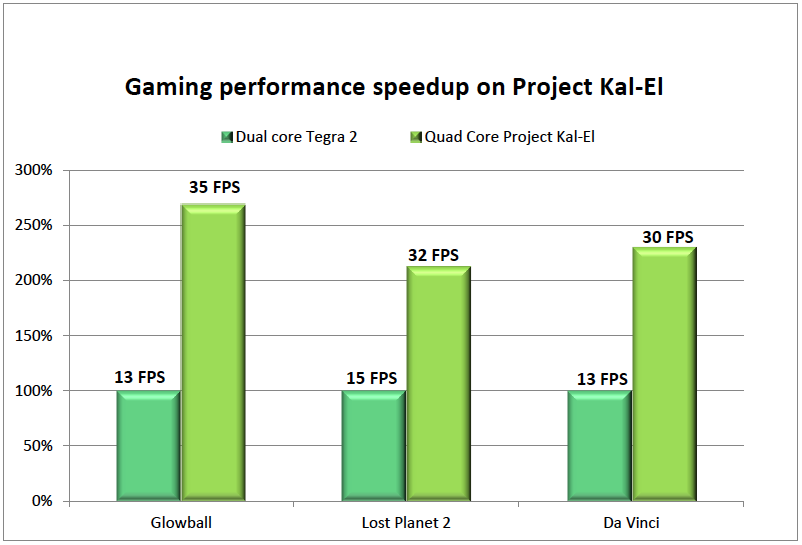More Details Emerge on Nvidia's Kal-El: Quint-Core?
Two whitepapers published this morning by Nvidia reveal more details on the company's next-gen Tegra SoC, better known as Kal-El or Tegra 3. Previous reports pegged the Kal-El SoC with four ARM Cortex processors and an additional 12-core GeForce GPU. This combination was touted as being able to deliver unprecedented mobile performance at the same power consumption of the Tegra 2.
More cores generally means more power consumption, which is why Nvidia's previous claims seemed a bit unrealistic. However, it turns out that Kal-El is technically a quint-core SoC, because it features a fifth "companion" CPU core that handles low overhead tasks such as syncing email, playing a ring tone, and keeping applications alive in standby mode.
In its implementation, Nvidia's borrows a feature of Qualcomm's design. Dual-core Snapdragons are some of the best ARM designs because the company uses low-power silicon and an asymmetric processor scheme (like Intel's TurboBoost except that each core is allowed to run at a different speed). The result is a very low power consumption processor that delivers incredible performance. (Read Third-Generation Snapdragon: The Dual-Core Scorpion for more information on Qualcomm's SnapDragon.)
| Kal-El | Companion CPU Core | Main CPU Cores (Symmetric Processing) |
|---|---|---|
| # of Cores | 1 | 4 |
| Function | Power-Optimized (Standby) | Performance |
| Architecture | Cortex A9 | Cortex A9 |
| Process Technology | Low Power (LP) | General |
| Operating Frequency | 0 MHz to 500 MHz | 0 MHz to Max GHz |
There are two problems with Qualcomm's approach. One, the lower power fab process is expensive and the yields aren't nearly as good as they are with general-fab. Two, operating systems (such as Android) manage processes based on the assumption that each core runs at the same speed. This isn't a problem for an asymmetric multi-core processor since most tasks on ARM aren't that intensive. However, in the future, the desktop-friendly Windows environment is going to be shipped on ARM-based notebooks and tablets.
We've seen the consequences of using a tablet more like a notebook or desktop; most folks have a tendency to hunt-and-peck for keys when they type on virtual keyboards. As a result, you don't feel the lack of performance as acutely because there's plenty of time for the system to process between each action. However, with a physical keyboard attached, typing becomes second nature again. As you start working more productively, you're faced with the realization that long pauses between commands are going to become more common. (Check out the video embedded above for a demonstration of the Tegra 2-powered Asus Eee Pad Transformer.)
Nvidia's quint-core Kal-El is an innovative way to forgo many of the technical issues with low power silicon while still reaping the benefit of long battery life and high performance. Early benchmarks are impressive. We've seen a case where two flash-heavy websites were running on a Kal-El tablet without any of the stuttering scrolling experiences on Tegra 2-devices.
On the graphics end, early benchmarks put Nvidia back in the performance game. Even with Honeycomb 3.2, Tegra 2 couldn't match the performance of the dual-core PowerVR SGX543MP2 found in Apple's A5 (iPad 2). The third-gen Tegra SoC is expected to deliver 50 percent better graphics performance, which puts Kal-El near (if not slightly ahead of) the SGX543MP2.
Get Tom's Hardware's best news and in-depth reviews, straight to your inbox.
However, Nvidia has its work cut out with Imagination Technologies being the current graphics leader in mobile computing. Kal-El will give Nvidia a big step forward, but competitors aren't sitting still either. Sony's upcoming Playstation Vita will be powered by a quad-core SGX543MP4 (basically double GPU horsepower of the iPad 2). Apple's iPad 3 also is likely to use an upgraded graphics solution also contracted from Imagination Technologies. Nvidia may have another card up its sleeve with Wayne (fourth-gen Tegra) slated to be released in 2012.
Either way, you can expect third-gen Tegra devices to be available within the next couple of months (in time for Christmas).
-
beckstrom12 Am I the only one that thinks it's cool that a tablet/phone proc can run Lost Planet 2?Reply -
tului I wonder if that fifth "companion" core is on a separate die called "The Fortress of Solitude"Reply -
amk09 falchardStill sucks compared to AMD Fusion platform.Reply
that's like comparing apples to oranges. These are SoC's we are dealing with with extremely low power profiles, AMD fusion is desktop and notebook CPU's/APU's that consume high amounts of power. -
stingstang 2010-tegra with one coreReply
2011- tegra with two cores+tegra with 4 cores
2012- tegra with...(8?) cores.
2015- tegra with 64 cores! Wooo! exciting future! -
acku tuluiThe "Snapdragon" story URL links back to this page. Not wherever it was supposed to go.Fixed!Reply
Cheers,
Andrew Ku
TomsHardware.com





